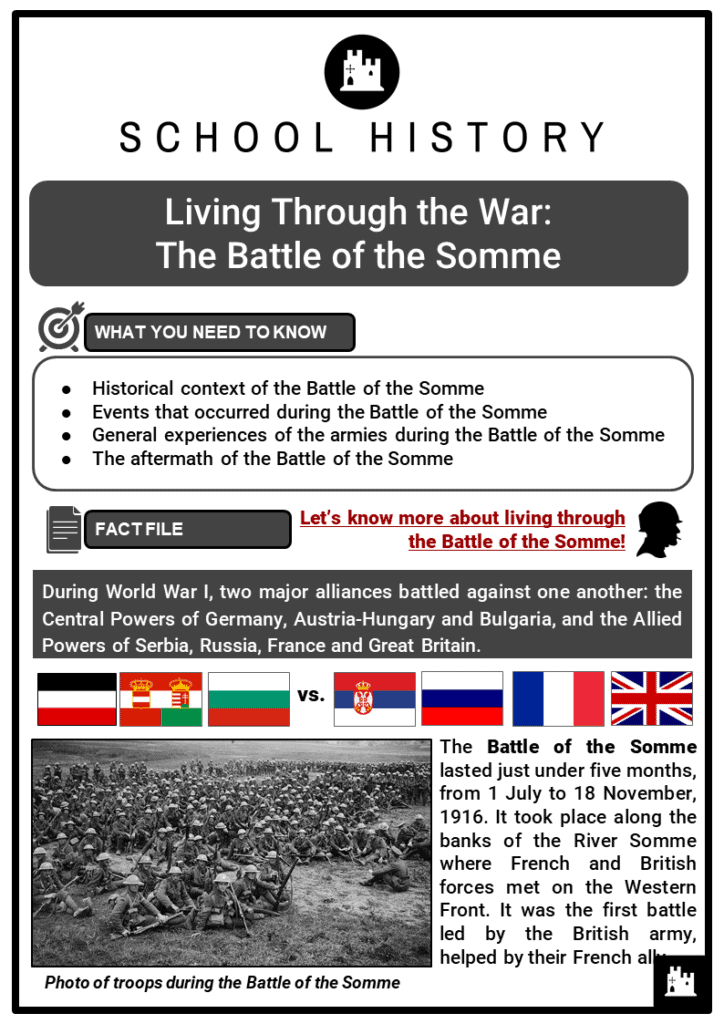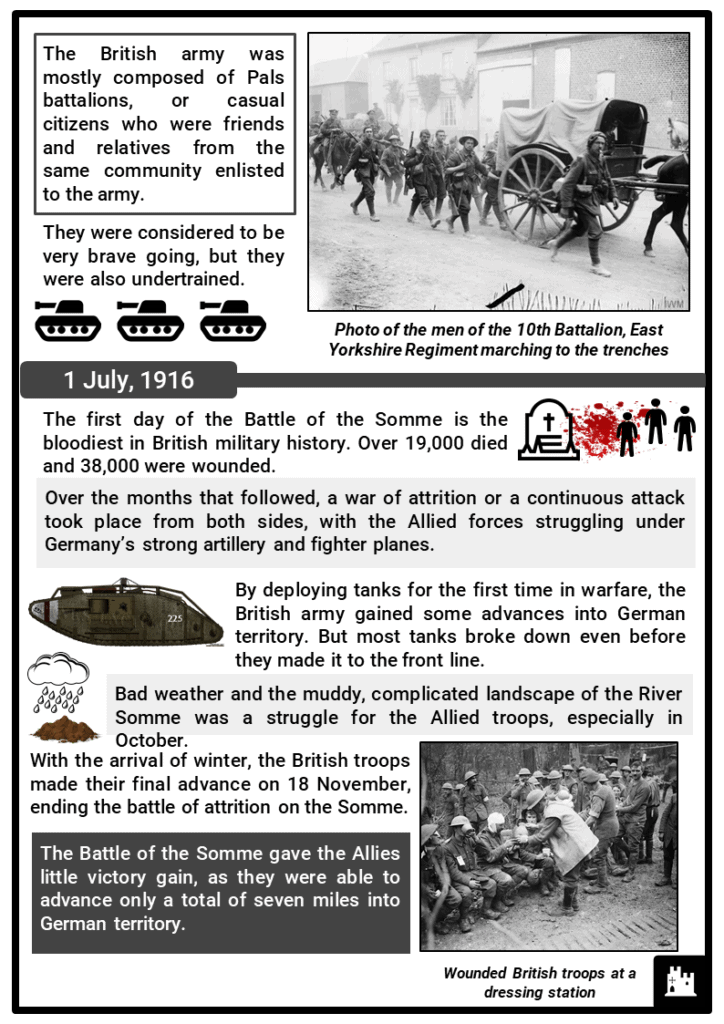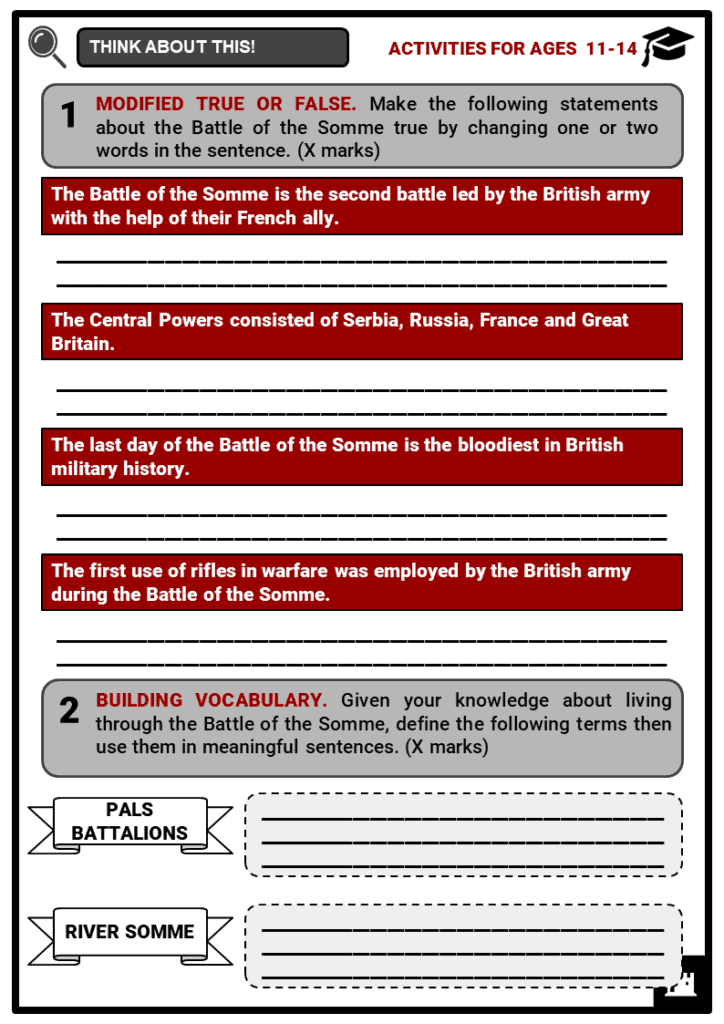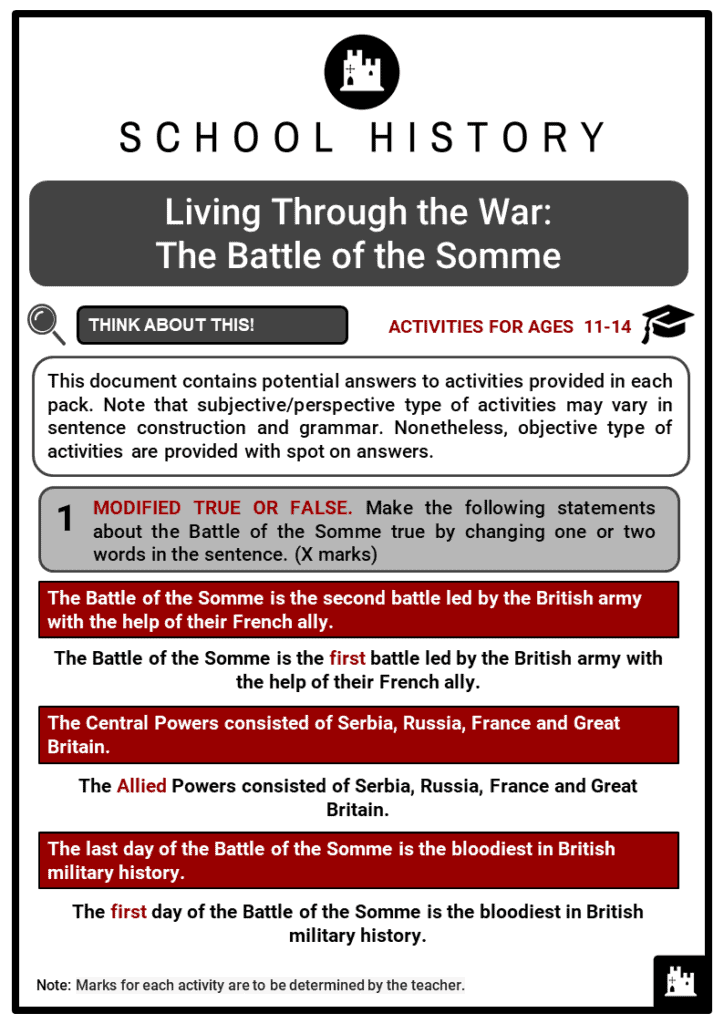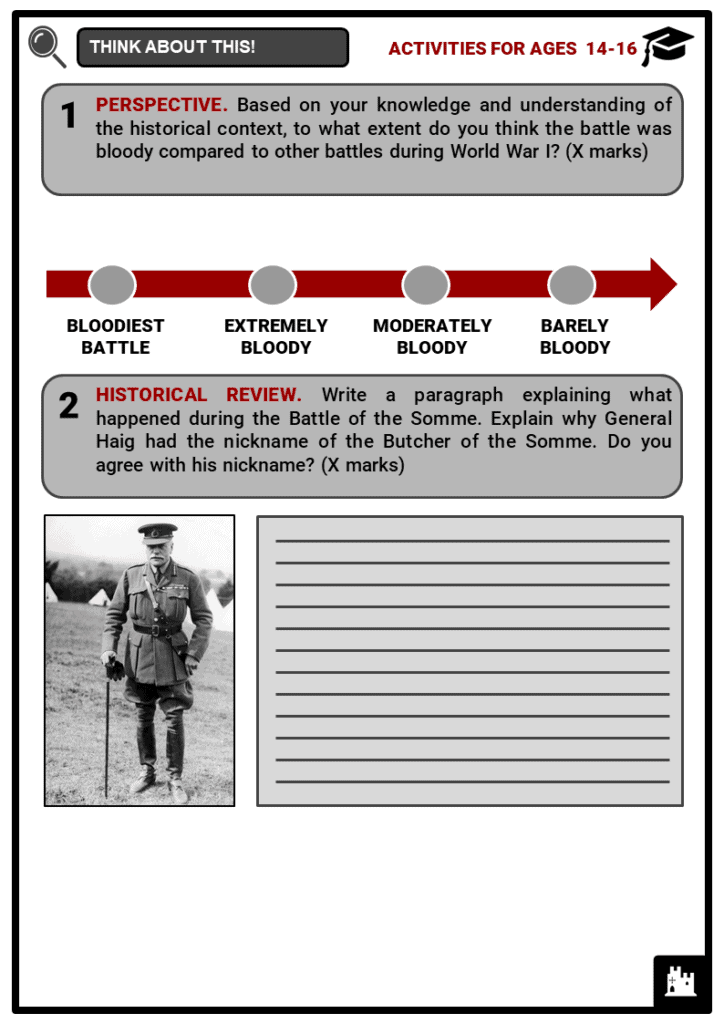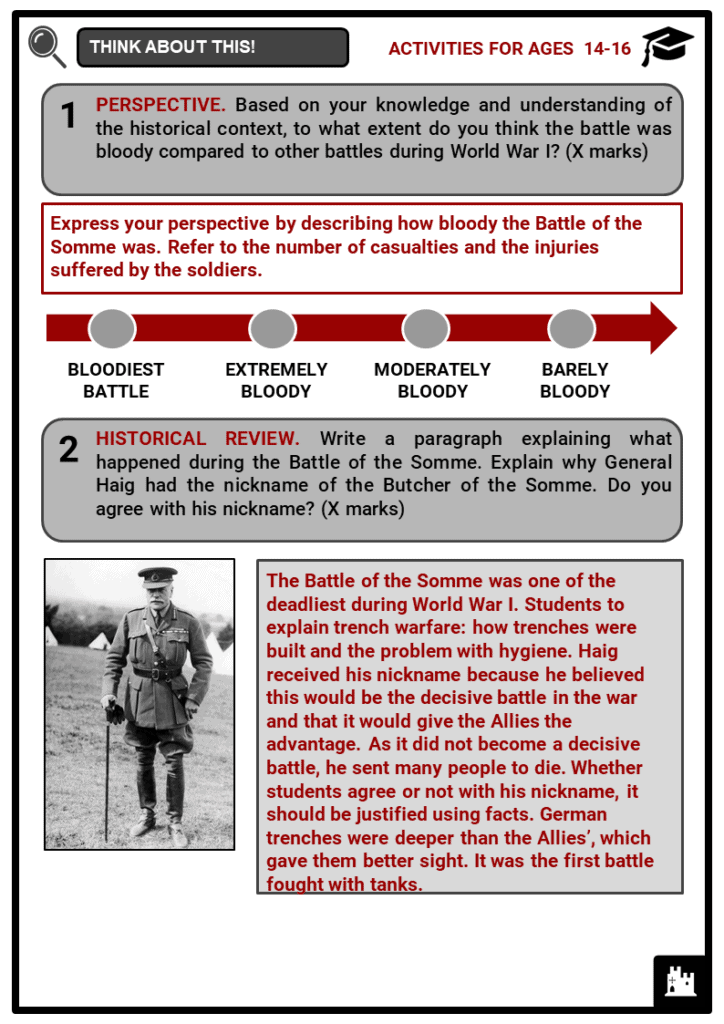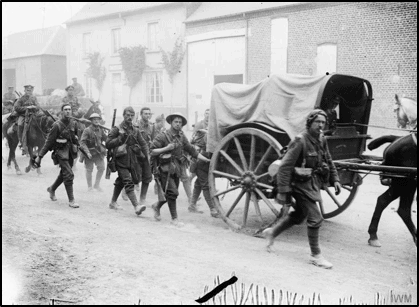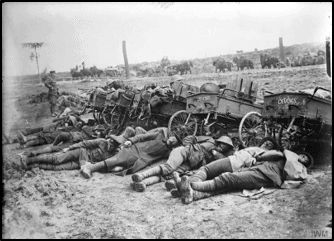Download Living Through the War: The Battle of the Somme Worksheets
Do you want to save dozens of hours in time? Get your evenings and weekends back? Be able to teach Living Through the War: The Battle of the Somme to your students?
Our worksheet bundle includes a fact file and printable worksheets and student activities. Perfect for both the classroom and homeschooling!
Table of Contents
Add a header to begin generating the table of contents
Summary
- Historical context of the Battle of the Somme
- Events that occurred during the Battle of the Somme
- General experiences of the armies during the Battle of the Somme
- The aftermath of the Battle of the Somme
Key Facts And Information
Let’s know more about living through the Battle of the Somme!
- During World War I, two major alliances battled against one another: the Central Powers of Germany, Austria-Hungary and Bulgaria, and the Allied Powers of Serbia, Russia, France and Great Britain.
- The Battle of the Somme lasted just under five months, from 1 July to 18 November, 1916. It took place along the banks of the River Somme where French and British forces met on the Western Front. It was the first battle led by the British army, helped by their French ally.
- The British army was mostly composed of Pals battalions, or casual citizens who were friends and relatives from the same community enlisted to the army.
- They were considered to be very brave going, but they were also undertrained.
- 1 July, 1916 - The first day of the Battle of the Somme is the bloodiest in British military history. Over 19,000 died and 38,000 were wounded.
- Over the months that followed, a war of attrition or a continuous attack took place from both sides, with the Allied forces struggling under Germany’s strong artillery and fighter planes.
- By deploying tanks for the first time in warfare, the British army gained some advances into German territory. But most tanks broke down even before they made it to the front line.
- Bad weather and the muddy, complicated landscape of the River Somme was a struggle for the Allied troops, especially in October.
- With the arrival of winter, the British troops made their final advance on 18 November, ending the battle of attrition on the Somme.
- The Battle of the Somme gave the Allies little victory gain, as they were able to advance only a total of seven miles into German territory.
- One of the most watched silent films in British history is The Battle of the Somme, the first feature-length film to record soldiers in action. Twenty million people saw it in its release in 1917.
World War I and Allied Powers
- The first great war, which initially started between Austria-Hungary and Serbia, was a global dispute between the Central Powers and the Allied Powers.
- When Austria-Hungary sought help from its ally Germany, Serbia’s ally Russia came to mobilise its army and defenses.
- On 4 August, 1914, war was then declared by Germany against Russia.
- The Central Powers were
composed of Austria-Hungary and Germany. Meanwhile, the Allied Powers included France, Russia and Great Britain, and (because of colonial rule) also Australia, Canada, India and South Africa.
The British and French Armies
- The Battle of the Somme, which lasted for five months from 1 July to 18 November, 1916, was a joint operation between British and French forces with the goal of gaining a decisive victory over the Germans during World War I.
- In December 1915, strategies were discussed by Allied commanders of launching a joint French and British attack in the region of the River Somme the following summer of 1916.
- The River Somme is where French and British forces met on the Western Front.
- The battle was the first offensive on the Western Front led by the British Army, rather than just acting as support to its French ally.
- The battle saw the first war employment of many British men who had volunteered for Army service after Lord Kitchener’s call for recruits in 1914.
- This included men in infantry units that were made up of friends, relatives and workmates from the same communities, also known as Pals battalions.
- This meant that the British Army that went to fight was made up of a largely citizen army of civilian volunteers rather than trained soldiers.
Battle of the Somme
- Prior to the start of the attack, the Allies launched a heavy artillery bombardment to cut the barbed wire guarding German defences along the northern side of the River Somme.
- Despite firing some 1.75 million shells, the barbed wire remained intact and the German positions, many of which are underground, were stronger than expected.
- Although lasting nearly five months, the Battle of the Somme is mainly remembered for its first day, considered the bloodiest day in the history of British military history.
- Some 19,240 British soldiers were killed and more than 38,000 were wounded by German machine gun and rifles.
- The French army’s advances to the south achieved more success on the first day as German defences were weaker in this area.
- The next days of the battle was a war of attrition or continuous attacks and offences from both sides in an attempt to wear down the opponent.
- On 15 July, British troops launched a massive attack on Bazentin Ridge in the northern part of Somme.
- Taken by surprise, the Germans were not able to keep the village of Longueval, 3.5 miles into their territory.
- By the end of July, advances had been at the expense of 160,000 German soldiers and 200,000 British and French soldiers.
- Towards the end of August, a change in the German side altered their strategy: a new defensive line behind the Somme front was built, allowing them to take more casualties in the advancing Allied troops.
- The British army tried to strengthen their offences through the first ever wartime use of tanks on 15 September.
- The tank strategy gave the British troops an advance of 1.5 miles towards the German territory. However, since most tanks were still in their development phase, many broke down before they made to the front lines.
- By this time, British casualties had reached 29,000, still far from a true breakthrough.
- Muddy terrains caused by bad weather made Allied attacks a struggle in October.
- The Allied troops were under fierce fire from German artillery and fighter planes. Their final advance of the battle was towards German positions in the Ancre River valley in mid-November.
- With the arrival of winter, the offensive was finally called to a halt on 18 November, ending the battle of attrition on the Somme.
- The British had advanced just seven miles and failed to break the German line by the 141st day of the war.
Aftermath
- The Battle of the Somme, especially its first day, is remembered for the devastating and brutal bloodbath that characterised trench warfare during World War I.
- British officers were also criticised for not taking stock of the devastating losses in their troops, and instead continuing with the offences.
- The Pals battalions were also broken down after the war.
- Despite not gaining a definite victory, the Allied offensive did inflict serious damage on German positions in France, forcing German troops to retreat behind the Hindenburg Line in March 1917.
- By the end of the Battle of the Somme, Germany’s casualties exceeded Britain’s by 450,000 (German) to 420,000 (British). Most importantly, the British forces had gained valuable experience, which would help them take the Western Front the following year.
Image sources:

